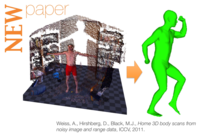Computer Vision Research at the Max Planck Institute for Intelligent Systems

The mathematics of vision
We seek mathematical and computational models that formalize the principles of perception and enable computers to understand the visual world of surfaces, materials, light and movement.
Seeing machines
Computer vision research in the department includes: optical flow estimation from sequences of images; statistical modeling of natural images and image motion; articulated human motion estimation and tracking; estimation of human body shape from images and video; representation and detection of motion discontinuities; estimation of intrinsic scene properties.
Decoding the brain
We also study perception and action in biological systems with a focus on understanding how populations of neurons work in concert to represent natural visual scenes or produce complex natural movement. Our approach is based on statistical models of the neural code. Some of our research is leading to new brain-machine interfaces and neural prostheses.
Impact
In addition to seeking answers to fundamental questions in perception and action, we always strive to have an impact on the world beyond academia. Whether developing neural prostheses for the severely disabled or web tools to help people understand BMI and health, we believe in putting our research in the hands of real users.
Scenes from Video Workshop, Barossa Valley, Australia, Dec. 10-13, 2013
New BMI visualizer on-line. Visualize your BMI and learn how BMI relates to body shape using our 3D body visualization tool.
The 3D shape of the human body is useful for applications in fitness, games and apparel. Accurate body scanners, however, are expensive, limiting the availability of 3D body models. We present a method for human shape reconstruction from noisy monocular image and range data using a single inexpensive commodity sensor (the Kinect).




